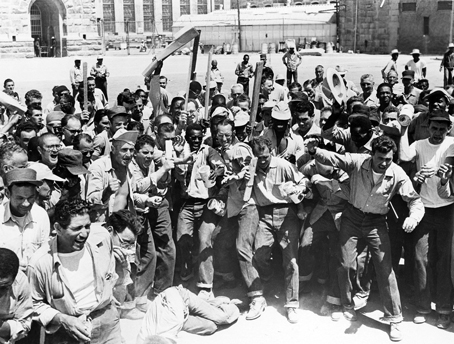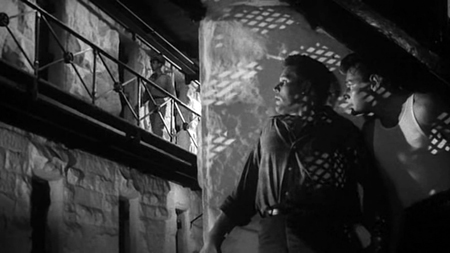|
|
Reviewed by Glenn Erickson
One of the many marvelous bits of killer dialogue in Sam Peckinpah's Ride the High Country occurs when crooked gunfighter Randolph Scott gently upbraids his young gunslinger associate for meekly surrendering both of them into the hands of the law. Scott asks if the kid has ever heard of Folsom Prison, because its walls are two feet thick and made of stone, and after a few years inside the kid might come to regret his rash decision. Just eight years before, Peckinpah had gotten his first movie job as an assistant to director Don Siegel. With typical Peckinpah luck, the movie in question turned out to be a breakout success. 1954's tough exposé of prison conditions Riot in Cell Block 11 spent three weeks filming in the real Folsom Prison, so it's clear that young Sam got a first-hand look at the place.
Riot is the brainchild of the one-of-a-kind producer Walter Wanger, who served several months in a minimum security institution for his part in one of Hollywood's more notable scandals (look it up). Upon his release Wanger determined to make a realistic prison picture to combat the myths perpetuated by earlier Big House epics. Underfunded by politicians and staffed by underpaid guards, America's prisons were experiencing a rash of riots like the one shown in the movie. Convicts knew they couldn't 'win', yet risked grievous reprisals for holding guards hostage and presenting lists of demands. The very liberal Wanger gravitated toward socially responsible filmmaking, and fought to make his major "issue" picture.
Don Siegel had directed several good movies since graduating from the Warner second-unit department, but Riot in Cell Block 11 is the winner that put him on the map. The documentary- like setting belies the fact that the picture is carefully blocked, with sequences designed for maximum tension and visual impact. Producer Wanger and director Siegel also do without name stars, giving the show over to a group of excellent character actors, all of whom seem totally committed to the show and come across like real prisoners. In 1954 the realism factor must have been powerful indeed.

The film benefits greatly from the granting of full access to a real Folsom Prison cell block. Pushed to the limit by bad conditions and abusive guards, the inmates in solitary confinement seize four guards and soon control the entire building. They trash everything in sight and punish fellow prisoners that protest against the riot. The angry and violent James Dunn (Neville Brand) becomes the leader in negotiations with Warden Reynolds (Emile Meyer), who notes that the prisoners' demands match his own reform proposals to the state legislature. Politically minded Commissioner Haskell (Frank Faylen) intervenes. He confronts the prisoners thinking he'll tough his way through, and for his trouble receives a knife wound to his shoulder. As the tension and anger build Dunn loses his leadership of the riot to Crazy Mike Carnie (Leo Gordon), a violent madman looking for an excuse to kill the guards. Warden Reynolds begs the Governor to save lives by signing the prisoners' list of demands, but the Governor stalls. The officials decide to storm the building by surprise, and prepare to dynamite one of the cell block walls. But word of this reaches the inmates, who move their hostages directly into harm's way. Can anybody defuse this situation?
Riot in Cell Block 11 plays a neat trick on the audience -- it feels four times more violent than it actually is. We see some beatings, a flying shiv and a brief battle in the prison yard, but the show is given life and menace by the fine work of a great ensemble cast. No stars or pretty boys are in sight. The pockmarked and gravel-voiced Neville Brand was a highly decorated war hero. His previous film work was mostly limited to one-note sadists like the horrid, grinning killer in D.O.A.. Brand's riot leader Dunn is dangerous and unstable but also shows a sense of responsibility. He happily forces the Warden and the Governor to bargain under the watchful eye of the press. When he displays the rubber hose and chains with which the guards beat the prisoners, Dunn is doing his best to get the message out. He's sufficiently idealistic to believe that airing the truth may do some good. The enormous Leo Gordon was an actual ex-felon, and as such was almost barred from filming at Folsom. One of the toughest-looking character actors ever in movies, Gordon also built an impressive film and TV writing career for himself, some of it for Roger Corman.

Richard Collins' script gives interesting parts to a number of familiar character actors. Dabbs Greer and Alvy Moore's brutal inmates contrast strongly with their nice-guy images from other pictures. Robert Osterloh is the very reasonable "Colonel", an ex-soldier who helps draft the sheet of demands. The film acknowledges the presence of black convicts, and gives Joel Fluellen a good scene. The only hint of a dated attitude is with William Phipps' homosexual, who is typed as one of the perverted 'sickos' that Dunn and the Colonel feel shouldn't be housed with the other inmates. The guards are represented by Paul Frees, Whit Bissell, Robert Burton and Carleton Young, while favorite face William Schallert is prominent among the reporters.
The best part of Riot in Cell Block 11 is seeing these talented, underutilized actors in such rewarding roles. This even applies to Emil Meyer, who is terrific as the responsible Warden. Meyer would later attain film noir immortality as Lt. Kello, the crooked cop in Sweet Smell of Success who says the immortal line, "Come back Sidney, I want to chas-TIZE you!".
Walter Wanger got his prison reform message across and Don Siegel enjoyed a major career boost from this modest hit, the title of which even rated a joke reference in Billy Wilder and George Axlerod's comedy The Seven Year Itch. Producer and director would soon re-team for the Sci-fi masterpiece Invasion of the Body Snatchers. Riot in Cell Block 11 is now acknowledged as one of the movies of the '50s that changed the landscape for American genre pictures.
The Criterion Collection's Dual-Format Blu-ray + DVD edition of Riot in Cell Block 11 is a perfect transfer from elements held directly by Paramount. I'd previously known only washed out VHS copies but the detailed HD image seen here presents Russell Harlan's cinematography at its best.
The film has unfortunately been formatted flat instead of widescreen, despite abundant evidence indicating that the aspect ratio should be at least 1.66:1. Actually, one needs to look no further than the credit text blocks in the opening titles to see that the upper and lower extremes of the frame are meant to be cropped away during projection. Criterion doesn't really defend its choice, and I won't speculate based on my experience elsewhere -- this fine company has championed proper formatting since the first letterboxed laserdiscs almost thirty years ago. But it is rather amusing that Criterion went to so much trouble last year to give us three separate transfers of Columbia's On the Waterfront. Mollifying unreasonable widescreen aspect ratio deniers apparently justified a scattershot effort. What, no colorized transfer?

This cropped frame grab is exactly 1.78:1.
On other counts disc producer Susan Arosteguy scores high. The audio commentary by Matthew H. Bernstein is fascinating, as are two readings by Don Siegel's son Kristoffer Tabori. One is from Siegel's own account of the making of the movie from his autobiography, and the other selects passages from Stuart Kaminsky's book on the director. A 1953 radio show exposé on prison conditions gives us a feeling for the contemporary attitude toward the subject.
A fat insert booklet has an essay by Chris Fujiwara, an article by producer Wanger and an excerpt from a Siegel tribute by Sam Peckinpah. Siegel's apprentice seems equally interested in gilding his own reputation, and repeats the contested story that he did a rewrite on the screenplay for Invasion of the Body Snatchers. But nobody can deny that Peckinpah was a decisive positive influence on the making of Riot in Cell Block 11. With his Old-California family connections to the state judiciary, Peckinpah was instantly befriended by the warden of Folsom Prison, who ignored Wanger and Siegel but personally promised that he'd help young Sam with any problems that came up during filming. Lowly production gopher Sam Peckinpah was surely the best hiring decision producer Wanger and Allied Artists ever made.
Thanks to Bob Furmanek for input on this review.
On a scale of Excellent, Good, Fair, and Poor,
Riot in Cell Block 11 Blu-ray + DVD rates:
Movie: Excellent
Video: Excellent but wrong aspect ratio
Sound: Excellent
Supplements: Commentary, two readings by Kristoffer Tabori, radio show, essay by Chris Fujiwara, articles by Walter Wanger and Sam Peckinpah.
Deaf and Hearing-impaired Friendly?
YES; Subtitles: English
Packaging: One Blu-ray disc plus one DVD in keep case
Reviewed: March 30, 2014

Text © Copyright 2014 Glenn Erickson
See more exclusive reviews on the Savant Main Page.
The version of this review on the Savant main site has additional images, footnotes and credits information, and may be updated and annotated with reader input and graphics.
Return to Top of Page
|

